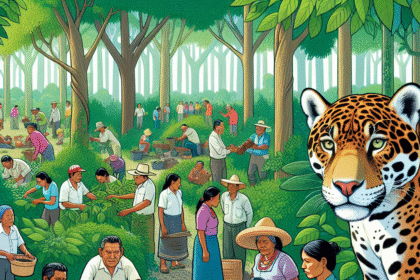Interactive Programs for Tulum Students on Jaguar Ecology
Understanding Jaguar Ecology
Jaguar (Panthera onca) ecology studies the behavior, habitat preferences, and roles of these majestic big cats in their ecosystems. In Tulum, known for its lush jungles and rich biodiversity, engaging students in interactive programs about jaguar ecology fosters appreciation and awareness of wildlife conservation. Educational initiatives can range from hands-on workshops to outdoor explorations, allowing students to experience jaguar habitats firsthand.
Importance of Jaguars in Ecosystems
Jaguars are apex predators and critical components of their ecosystems. They help maintain the balance between species populations and contribute to the health of the forest by controlling herbivore populations. By teaching students about the ecological role of jaguars, these interactive programs can instill a sense of responsibility towards wildlife conservation.
Program Components
Field Workshops
Field workshops are pivotal in immersing students in the environment where jaguars thrive. Local experts lead these excursions, guiding students through dense jungles and wetlands. Activities during field workshops include:
- Habitat Mapping: Students learn to identify different habitats (primary and secondary forests, riverbanks) and understand their importance to jaguar survival.
- Camera Trapping: Participants set up camera traps to monitor wildlife. Analyzing the data collected helps students understand jaguar behaviors, movement patterns, and population densities.
- Track and Sign Identification: Teaching students how to identify jaguar tracks and signs of their presence (scrapes, scat) is essential for understanding their habits.
Interactive Seminars
Interactive seminars can supplement hands-on experiences by delving into scientific research and conservation strategies:
- Guest Speakers: Bringing in wildlife biologists and conservationists allows students to hear firsthand about jaguar studies, challenges, and triumphs in conservation efforts.
- Data Analysis Workshops: Students gain insights into how scientists analyze biodiversity data, empowering them to understand the significance of research in wildlife conservation.
- Group Discussions: Encouraging students to participate in discussions fosters critical thinking and collaborative learning about jaguar ecology and conservation.
Educational Technology Integration
Incorporating technology into educational programs enhances engagement and knowledge retention:
Virtual Reality Experiences
Virtual reality (VR) immerses students in the jaguar’s habitat. By wearing VR headsets, students can explore the tropical rainforest, encountering other species and learning about their interactions. Such experiences can ignite enthusiasm for conservation and increase their understanding of habitat complexity.
Mobile Apps
Mobile applications can be used to support field studies, offering identification guides for fauna and flora, as well as collecting and analyzing data on the go.
- Eco-Tracker: Students can input their observations, track species sightings, and contribute to citizen science by sharing data with researchers.
- Jaguar Spotter: This app allows students to log jaguar sightings and receive information about ranges, dietary habits, and conservation status, reinforcing learning through gamification.
Community Involvement
Interactive programs enhance their impact when engaging the local community:
- Conservation Partnerships: Collaborating with local NGOs dedicated to jaguar conservation ensures that students learn from seasoned professionals who are actively working on preserving habitats.
- Awareness Campaigns: Students can participate in or organize community outreach initiatives to promote awareness about the ecological importance of jaguars and the threats they face, such as habitat destruction and poaching.
Experiential Learning
To genuinely engage students, programs may involve experiential learning components that allow them to participate in active conservation efforts:
Volunteer Projects
Student volunteers can partake in local conservation projects, such as reforestation, wildlife rescue, or habitat restoration efforts. These projects help students develop a deeper connection to the environment while actively contributing to wildlife conservation.
- Reforestation Events: Planting native tree species restores habitats that are vital for jaguar survival.
- Wildlife Monitoring: Participating in monitoring projects equips students with field skills and real-world experience in conservation efforts.
Internships
Programs that offer internships with conservation organizations can provide students with valuable experience in wildlife management and research:
- Research Internships: Gaining hands-on experience in species monitoring, data collection, or behavioral studies allows students to apply their knowledge in real scenarios.
- Conservation Advocacy: Internships can also focus on awareness-raising and educating the public on jaguar protection and ecosystem services.
Curriculum Development
To further enhance learning outcomes, it’s essential to integrate jaguar ecology into existing educational curricula:
-
Project-Based Learning: Assigning projects where students research various aspects of jaguar ecology promotes self-directed learning. Each project could address conservation challenges and potential local solutions.
- Multidisciplinary Approaches: Incorporating elements of social studies, biology, and environmental science provides a holistic view of jaguar ecology and conservation.
Outdoor Education Programs
Creating immersive outdoor education experiences can cultivate a connection to nature while teaching about jaguar conservation:
- Nature Treks: Guided hikes focusing on local ecology, emphasizing species interdependence and the ecological role of apex predators.
- Outdoor Classrooms: Utilizing natural settings as classrooms can inspire creativity and curiosity in students, enabling hands-on learning about ecosystems and wildlife.
Feedback and Evaluation
Gathering feedback from participants is crucial for continuous improvement of the programs. Surveys after every initiative can help assess student learning outcomes, engagement levels, and overall satisfaction.
Final Thoughts
Interactive programs for Tulum students on jaguar ecology are instrumental in fostering a deeper understanding of wildlife conservation. Utilizing diverse educational methodologies such as field workshops, technology integration, experiential learning, and community engagement creates an enriching experience that aligns with modern educational trends and ecological goals. These efforts ensure that the next generation is equipped with the skills and awareness necessary to protect our planet’s precious biodiversity, centering on the majestic jaguar.







